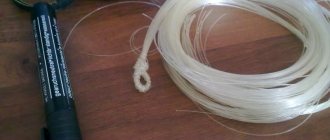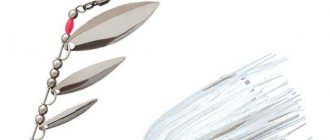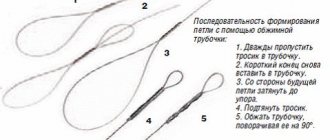By bite alarms, fishermen understand certain devices attached to fishing rods that help detect fish bites.
The price of fishing alarms can be very different, ranging from 20 rubles for simple bells, and ending with entire carp installations for several hundred dollars.
But if you came to this article, then most likely you want to make your own bite alarm, investing a minimum of money and time.
Types of bite alarms
So, let's start by figuring out how alarms can notify us about a bite, and they can do this in the following ways:
- Sound signal;
- light signal;
- movement.
Sound alarms include: rattles, bells, electronic sound sensors and other noise elements.
Light sticks include glow sticks that are attached directly to the tip of the fishing rod or to the float. Signal lights are used only at night.
As for motion alarms, these include: soft tips, side nods, or bright rattles that are attached to a sagging fishing line. Side nods can catch the slightest bites and can be used both on a spinning rod and on a donk.
We've sorted out the theory, now let's move on to practice, in which we will try to clearly describe the process of assembling various alarms from improvised means and tools.
Visual bite alarms
Visual alarms are the simplest in design and functionality, but no less effective devices.
Varieties
As a rule, most anglers use the following types of visual bite alarms very productively. This:
- floats;
- nod;
- fireflies;
- foil tubes.
Advantages and disadvantages
The advantages of using visual alarms include the ability to relatively accurately guess when a fish is biting and make a hook in time, thereby ensuring a possible catch. The disadvantages include the fact that even visual signals may not be noticed by an angler, especially a beginner, in sufficient time.
Do-it-yourself sound alarm (instructions)
This alarm is very easy to manufacture, which is why it is most popular among fishermen, especially mature ones.
Stages of a homemade bell:
- Take out a small bell;
- find a hollow rubber hose up to three centimeters in diameter;
- cut a piece of hose 2-5 centimeters long;
- make a slot in one part of the tube into which the fishing line will go;
- put this tube on the bell, if it does not fit tightly, then glue it with glue;
- wrap a braided or nylon cord around this entire installation.
The principle of such an alarm is that it clings to the fishing line with a tube with a slot, at the moment of hooking the bell comes off the fishing line so as not to interfere with fishing, and we tied the thread so that the bell does not fly away and get lost. Tie the thread to something that the rod rests on, for example, a flyer or a rod rest.
You can also use a wine or champagne cork along with a rubber tube. If we compare this alarm with a rattle, which is attached like a clothespin, then the bell turns out to be more convenient, since it resets itself when sweeping, and the rattle must be removed manually so that it does not interfere with sweeping.
Sound bite alarms
Sound alarms, unlike visual ones, also indicate a bite using sound, which makes their use more convenient.
The alarm is attached to the top of the feeder. The source of the sound signal can be bells, bells, hollow metal tubes in which small metal elements or bearing balls are placed.
In a situation where there is a bite, the device attached to the top of the feeder begins to twitch, which is certainly reflected by a sound signal.
Types of alarm:
- bell;
- bell.
The only nuance of this type of alarm is the requirement for careful handling. The implementation of the cast should be done in a smooth manner and preferably at a close distance. Otherwise, the alarm will be tangled!
Do-it-yourself light electronic bite alarm
A simple analogue of this signaling device is a phosphorus stick, which glows if it is broken.
But the good thing about our device is that it lasts for a long time, and the phosphorus stick only lasts for the night.
So, for our homemade product you will need the following materials and tools:
- Straws for cocktails;
- scissors;
- glue gun with glue sticks;
- LEDs;
- batteries (3 V);
- heat-shrink tubing;
- lighter;
- crocodile clips.
Sequencing:
- Cut a piece of straw 3-5 cm long.
- Fill a cut piece of straw with hot glue.
- While the glue is hot, insert the LED into the straw. The LED leads should stick out about 5 mm.
- Insert the coin cell battery into the heat shrink.
- Cut off the excess part of the heat shrink so that 1-2 cm remains on each side of the tube.
- Insert the straws into the heat shrink on both sides.
- Use a lighter to heat the shrink wrap to pull it off over the straw.
- Connect the straw to the diode and heat shrink so that one contact of the diode touches one side of the battery, and the other contacts the other side of the battery.
- Glue a hairpin onto the free end of the tube with a glue gun, which will be attached to the fishing line.
And now the same thing only in video format. Enjoy watching.
Another option for an electronic signaling device
Here are a few more options for homemade bite alarms
How to choose electronic bite alarms: varieties
The content of the article:
How does an electronic alarm work?
The rod is placed on such a holder, and the fishing line is placed on a rotating roller, with the help of which the slightest movements of the fishing line are recorded in case of a bite.
Electronic alarms provide the ability to adjust sensitivity, that is, depending on the selected mode, line pulls from 1-2 mm to 3-4 cm can be recorded.
This is a very important function, since adjusting the sensitivity will allow you to use alarms for catching almost any fish and in any body of water, without being tied to a certain permissible current strength.
The notification itself can be a sound signal or LED lighting effects.
The volume and type of sound signals can usually also be individually adjusted.
Electronic alarm with pager
Even more functional are electronic bite alarms, used in conjunction with a kind of remote pager. This is very convenient, for example, in cases where several fishing rods are cast. In addition, the pager can notify not only about the fact of the movement of the fishing line, but also about its nature, that is, a pull has occurred in the direction from the shore or towards the shore.
The connection between the alarms and the pager can be wired or wireless. Of course, the second option is much more convenient, because it allows the fisherman to calmly move away from the fishing rods and do other things.
Like the alarm holder itself, the pager can also be customized.
So, on the holder you can completely remove the sound signal, but leave it on the pager; similarly with lighting effects. During night fishing, it is better to leave only a light signal or vibration signal, turning off the sound alert.
All devices, as a rule, are powered by various batteries or batteries that are easily replaced. Entire sets with 3-4 alarm holders and 1 wireless pager are available for sale.
Electronic signaling kits
As mentioned above, kits that include several alarms and a wireless pager are especially convenient, which allows you to fish with several fishing rods at the same time and at the same time do, for example, cooking or lighting a fire. Often, the devices themselves also come with several covers, a stand, and a set of batteries. The kits themselves are sold in compact, high-quality cases.
Rattle built into stand
And here is another option for a signaling device that we found on the Internet. A very interesting idea. The recess for the fishing rod is stretched with rubber bands between bent wires.
It is worth noting that this design is not sensitive and is capable of detecting only powerful bites.
Author of the article: Vitaly Leonidovich Ivanov, 2021.
Blitz tips
- By using a nod, you can recognize the bite of less active fish. To form such a nod, you need wire material or a thin metal plate. In this case, the nod is attached to the tip of the rod using electrical tape, through which the fishing line is threaded. In order to most effectively capture the bite and touch of the fish, the nod should be attached to the side of the end of the rod.
- In the case of using a firefly indicator light and using light tubes for a long time, they should be placed in freezers, naturally after fishing!
- To increase the effectiveness of side alarms for the presence of fish, it is advisable to place a certain brightly colored object on the tip of the hook, which can be, for example, a ball.
- To achieve greater sensitivity of the bells, you need to significantly stretch the springs to which the bells are attached.
Schemes of 4 electronic bite alarms and 3 mechanical ones - do it yourself
Probably, every avid fisherman, sooner or later, has the thought that it would be nice to have an assistant on his farm, a small one, but an observant one.
This assistant is called a “bite alarm”. But many people not only want to buy it, but to make a signaling device with their own hands.
Today we will talk about what types of alarms there are and how to make some of them.
The simplest bite alarms (principles of operation, manufacturing instructions):
Every fisherman has eyes, ears and hands to determine the bite. The mechanical signaling device is designed, due to its operating principle, to indicate the beginning of a bite through visual, acoustic or tactile contact.
Mechanical visual alarms
Nod. The simplest devices are the familiar float or the tip of a fishing rod (nod). These types of alarms are familiar to everyone. Every fisherman knows how to make a float and nod himself, or which one to buy.
Foil tube. Also, there are slightly different alarms, which are based on the principle of operation on the vibration of the fishing line. The simplest visual one is a foil tube.
- Take aluminum foil and roll it into a tube.
- Then we put the tube on the main fishing line.
- You need to thread the line between the reel and the first ring on the rod - the line will sag in this place.
As the bite begins, the sag of the line decreases, we understand that the fish has begun to grab the bait. Aluminum foil is good because it shimmers in the sun (its movement is clearly visible), and also rustles when bouncing.
Disadvantage - it is useless in windy conditions (reason is the lightness of the material).
Mechanical acoustic alarms
The right bell. Let's talk about a simple acoustic signaling device - these are bells. Our design is much better than store-bought bells, since the bell flies off the tackle during hooking and does not interfere with fishing.
- We buy a bell and remove everything that hangs on it.
- We are looking for a rubber hose about three centimeters in diameter. When searching, pay attention to the fact that its walls are thin.
- On the hose we measure a piece one and a half centimeters in length.
- Cut off the measured ring and see what shape it has. If it’s a circle, then we cut along one side anywhere, but if it’s an oval, then we make a cut on one of the elongated sides.
- Now we need two nuts and a bolt. The size of the bolt is such that it fits into the ear of the bell.
- Now you need to make a hole at one end of the cut rubber ring equal to the diameter of the bolt (it is better to drill at low speeds).
- We thread the bolt through the hole in the rubber ring (with the head inside the ring). You will get a hook made of a rubber ring with a bolt protruding from one side.
- We put a piece of thick fishing line a meter long on the bolt with a tightening loop.
- Tighten the loop.
- Now we put on the bell, press everything together and tighten it with a nut, then screw on the second nut to lock the first.
We have a bell with a rubber hook. We hang it on the fishing line closer to the tip of the rod. When hooking, the bell may fly off - in order not to lose it, we tie the free end of the fishing line on our structure to a peg in the ground.
This design is much better than the cheap bells that are sold in stores. Because the signaling device flies off the rod. You don't irritate yourself or nearby fishermen. And also you don’t scare away the fish.
Electronic signaling devices
Having thought about the alarm and appreciating its advantages, I want more from it. A mechanical alarm requires mandatory control by the fisherman over its operation, that is, being near the fishing rods all the time.
What if you want more? To go away for natural needs, cook food, just relax and stretch your legs, here an electronic alarm comes to the rescue, it is also called a swinger for fishing.
It does not require constant presence near the rod and will indicate a bite with a visual (light) or sound signal. There are a sufficient number of types, types and models on sale.
Can be divided into types:
- visual
- sound
- combined
The principle of operation is just as simple - the fishing line passes through the slot, there is a small reel in the slot, and when it moves, a signal is triggered.
So, we described primitive mechanical alarms and briefly talked about factory-made electronic alarms, which are sold in stores. Now we’ll tell you how to make a more or less simple design of a mechanical signaling device, as well as how to assemble an electronic one yourself.
Design and manufacture of a simple side mechanical signaling device
We will need the following components:
- Latch fastener for PVC pipes (used for fastening to a wall, ceiling or floor, the pipe itself is snapped into it).
- Steel (elastic) wire 20 cm long and 0.8 - 1 mm in diameter.
- Nylon thread, waterproof glue, any paint for metal of a “poisonous-bright” color (paint can be bought in cans) or a self-adhesive film of a bright color.
- A rod or tube (guide) 8-10 cm long. The diameter of the tube is such that it fits tightly into the side hole for the PVC pipe holder.
Step-by-step instruction
Let's start assembling our alarm device.
- We make a hole at the end of the tube or rod according to the diameter of the wire.
- We bend the wire in an arc, measure 5 cm from one end and bend it 90 degrees outward from the inner bend of the arc.
- We thread the wire through the hole in the tube or rod. We will have a curved tip parallel to the guide.
- We coat the tip of the wire and the guide with glue and wrap it tightly with thread in several layers.
- We coat each layer with glue.
- Once it dries, you can either paint this place or open it with varnish (for example, for nails), as an option, put a heat-shrinkable tube over the gluing area and use a lighter to encircle it along the diameter.
- At the other end we bend the hook for winding the main fishing line.
- We insert the guide into the pipe holder (it is better to place it on glue).
- We paint with “poisonous” paint or cover with a bright film 5–7 centimeters of the tip of the holder on the side of the fishing line hook.
- We put it on the rod handle after the reel. The arc wire should be on the side.
- We grab the ends of the holder with a thick rubber band (so as not to fly off). We hook the main line after the reel to the hook on the wire arc.
When biting, the line tightens and bends in an arc. Based on the vibrations of the bright tip of the arc, it is easy to determine the moment of the bite.
Option 1. Simple circuit of an electronic signaling device
The line tension sensor is made from a contact group from the RPU-2 relay. It is only important to set the relay to open at the slightest movement of the fishing line, but this can be done very easily during assembly.
Option 2. Simple circuit of a waiting sound and light alarm
A very simple scheme. The sensor is based on the same RPU-2 relay or any other analogue. The fishing line is wound behind the sensor and connector SA1 is closed manually.
As soon as the line is tensioned during a bite, it will pass through the sensor and the chain will allow the speaker to signal the bite. You can also install an LED in parallel for light signaling.
Read the article about fireflies for night fishing with a battery.
Option 3. Electronic alarm from a key fob with a melody
A very simple scheme and does not require additional description. The RPU-2 relay or its equivalent is still used.
Option 4. A more complex circuit of a waiting bite alarm
To assemble an electronic signaling device, you need to have at least minimal design skills - what housing to place, what system is best to come up with, mounting method, etc. Each designer determines this for himself. We will tell you about the very principle of operation of the electronic signaling device and its components. For assembly you will need:
- 3 volt battery (or several connected in series).
- Contacts from a broken alarm clock or toy.
- The reed switch is open, without a magnet.
- Magnet (can be used from a furniture latch).
- LED or buzzer (or both for a combination alarm).
Here is the most complete circuit of an electronic sound signaling device.
The principle of operation of such a signaling device is as follows: when a magnet is supplied to the reed switch (during a bite), the circuit closes and transmits electric current to the LED or tweeter (or to both elements). The LED lights up or the beeper buzzes, signaling the start of a bite.
Such a circuit can be used, for example, in the mechanical signaling device described above - improving it into an electronic, combined one.
In this case, we need to bend the arc so that it is closer to the rod with the tip where the hook is located, through which the main line passes.
You need to attach a magnet to this tip of the arc, and attach the batteries, a reed switch and an LED with a buzzer located inside some tube or box to the rod.
How to make a spring for fishing on a feeder - the technology for creating a pseudo-method feeder.
A detailed carp guide for beginning carp anglers. Construction of basic gear and many other aspects.
Bait for wild carp at this link.
When biting, the fishing line will stretch and bend the wire arc with the magnet, bringing it closer to the reed switch. The reed switch will close the circuit and supply power to the LED and buzzer. You can put a toggle switch in the circuit to turn the tweeter on and off at will, and then it will only work in the on position.
To ensure that the LED always works, install the toggle switch in the circuit after the LED, so that the LED itself is not left without power in the off position. It turns out to be a wonderful signaling device.
Electronic signaling device Megatext and its operating principle
You can read a detailed article about it here. Suitable for ice and summer fishing with bottom gear.
The advantage of this design is that in the open state our alarm does not consume power from the elements at all. It can be used at any time of the day.
If you need to move away, you just need to turn on the buzzer and it will notify you of a bite at a distance from the rod. In case of failure or discharge of the batteries, such a detector will be able to operate in mechanical mode.
It will be enough to remove the magnet and bend the arc to its old position. Successful hooks to you.
Source: https://primanki.com/snasti/fider/signalizator-poklevki-svoimi-rukami.html
Donka with a bite alarm spring
The diagram for casting a casting bottom, fixed with a ring of a clock spring on a support peg with a zero angle of inclination, is shown in the drawing. On ordinary hooks and rubber donks, the angle of the peg can be of fundamental importance in the fishing process.
To set up the spring bait alarm, let’s pay attention to the drawing, where the carrying line of the bait is wound around the support peg approximately to the middle.
After casting the end rig of the casting bottom to the fishing spot on the rod, we put on the bite alarm mounting ring.
As a result, we get a tackle that practically does not react to gusts of wind and where there is simply nothing to be swayed by the wave. A casting bottom with a spring bite alarm and the same fastening ring is equally suitable for fishing both in enclosed reservoirs and on the river. For example, in conditions of fishing for bream in the current.
Reaction of the donkey spring to a bite
When a fish bites in real fishing conditions, the fishing line slips out of the wire bracket soldered to the spring.
The sensitivity of the spring to bites is adjusted in the process of fishing by forced bending of the elastic spring of the casting bottom. The sensitivity of the fishing alarm will increase as the bending radius of the spring decreases.
Fans of fishing with casting bottoms with sound bite alarms attached to the tackle can hang a light bell either between the spring and the equipment of the summer casting bottom, or on a short piece of supporting fishing line between the alarm spring and the support peg.
Follow the link to see how you can equip a fishing spot with a casting bottom or a rubber band with a vertical bite alarm. This could be a weight or a bell.
Let's take a closer look at the procedure for setting up the most common cast-on donkey, which fishermen more often call a throw-on.
How to make a bite alarm for a feeder with your own hands
For an angler with experience and tools, making bite alarms for a feeder with your own hands is not difficult. With the correct selection of materials, a minimum of time is spent on the entire process. True, this applies to devices not related to electronics. The article describes how to make the simplest signaling devices, a side nod and a pendulum-type signaling device.
Here are two typical examples of making homemade bite alarms for a feeder from scrap materials.
- Stopper for a wine bottle. The cork slides freely along the rig when casting and reeling in, does not damage the rod blank during a sharp bite or hook, and does not interfere with intense biting conditions.
- Aluminum foil from chocolate. You need to roll one sheet several times into a 2 cm wide ribbon and wrap it around a fishing line - you will get a simple and effective guard.
The gatehouses described are simple and can be quickly made while fishing.
What kind of alarms exist for feeders and donkeys, read here.
There are several ways to make such a homemade signaling device for donkey. Here is one of them that can be taken as a basis. So:
- a piece of steel wire with a diameter of 0.8-1 mm and a length of 40 cm (you can use a cable or a steel plate from an old car wiper);
- clamp for PVC water pipes;
- a metal rod (nail or thin tube) suitable in diameter to the hole in the plastic clamp;
- mounting silk thread;
- glue.
- drill a hole in the rod (if you are using a plate, then it is not necessary);
- bend the wire on one side at 90 degrees at a distance of 5 cm;
- on the other side we make a small hook for winding the fishing line;
- we thread a five-centimeter piece into the rod and wrap it with thread;
- cover the joint with glue (you can also use varnish);
- Lubricate the rod with glue and install it in the clamp, selecting the angle of inclination (if there is no hole, it must be drilled).
The device can be improved and removable rods can be made for different tests, but then the combination of diameters must be precisely selected. For better visibility, we paint the signaling device.
Instead of a clamp for PVC pipes, you can take hard foam and select a groove on one side equal to the diameter of the fishing rod blank. Then make a hole for the pin and place it on the glue. You will have to secure the base of the alarm with electrical tape - only the rod with the wire can be changed during fishing. You can also secure it with rubber rings that are put on the fishing rod in advance, but they are susceptible to sunlight and quickly fail.
Some anglers prefer to use pendulum alarms. They are attached to the upper part of the rod with one end of the guide ring, and the other end clings to the fishing line. A small weight provides slack and signals a bite by raising or lowering the guard.
As a rule, factory fittings are used. But such a device for the feeder can be made with your own hands. Moreover, it causes less damage to the rod blank. To do this you will need:
- a plastic tube from 15 to 20 cm long (suitable for a cocktail, but it is not rigid enough);
- steel wire 0.5-08 mm thick;
- thick foam or cork from a wine bottle;
- glue.
The manufacturing process consists of the following stages:
- give the foam a cylindrical shape (for cork we skip this step);
- drill a hole with a diameter equal to the outer thickness of the tube;
- Lubricate the tube with glue and put foam on it so that there is a distance of 3-4 cm from one edge;
- we thread the wire into the tube and make loops - you can leave a small gap under the pass ring, under the fishing line (in the photo on the right) we make a small overlap so that the alarm does not jump off.
The loops should be perpendicular to each other. Otherwise the device will not work. To prevent the larger ring from damaging the blank when casting and hooking, we recommend putting a cambric on it.
For better visibility, the device is painted in bright light. To sound the alarm, it is equipped with bells. When fishing at night, a “firefly” attached to a tube will help you see the bite.
To make an electronic bite alarm for a feeder, you need to have minimal skills in assembling electronic devices. We recommend this device design.
We recommend finding the following items:
- housing for the device (you can use an old plug to charge your mobile phone);
- material for the lever – steel wire 2 mm thick;
- sound generator (squeaker), a device from a Chinese alarm clock is suitable for this purpose;
- microswitch;
- a battery that fits the tweeter;
- LED - light indicator (you can take it from a lighter with backlight - there are fasteners there).
The lever must be positioned so that when the fishing line twitches, it presses the switch and closes the circuit. After this, a sound is heard and the LED lights up.
In some cases, it is more appropriate to replace the microswitch with a reed switch, which acts as a sensor. But then you also need a magnet, the approach of which the reed switch is accompanied by a sound signal. This scheme is a little more complicated than with a toggle switch.
It is quite possible to make alarms for bottom gear yourself if you have a small set of materials, skills and tools. In some cases, homemade devices provide even greater effect than industrial devices.











